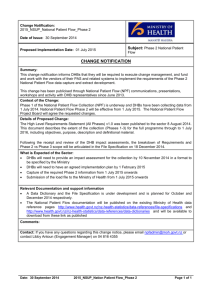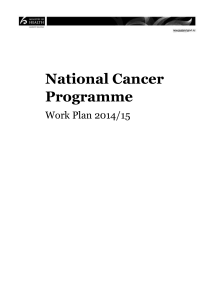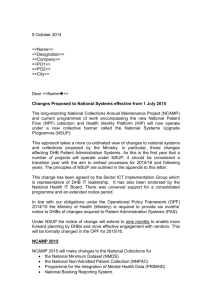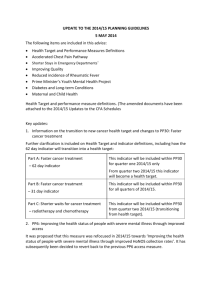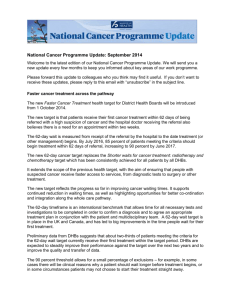National Cancer Programme Work Plan 2015/16
advertisement
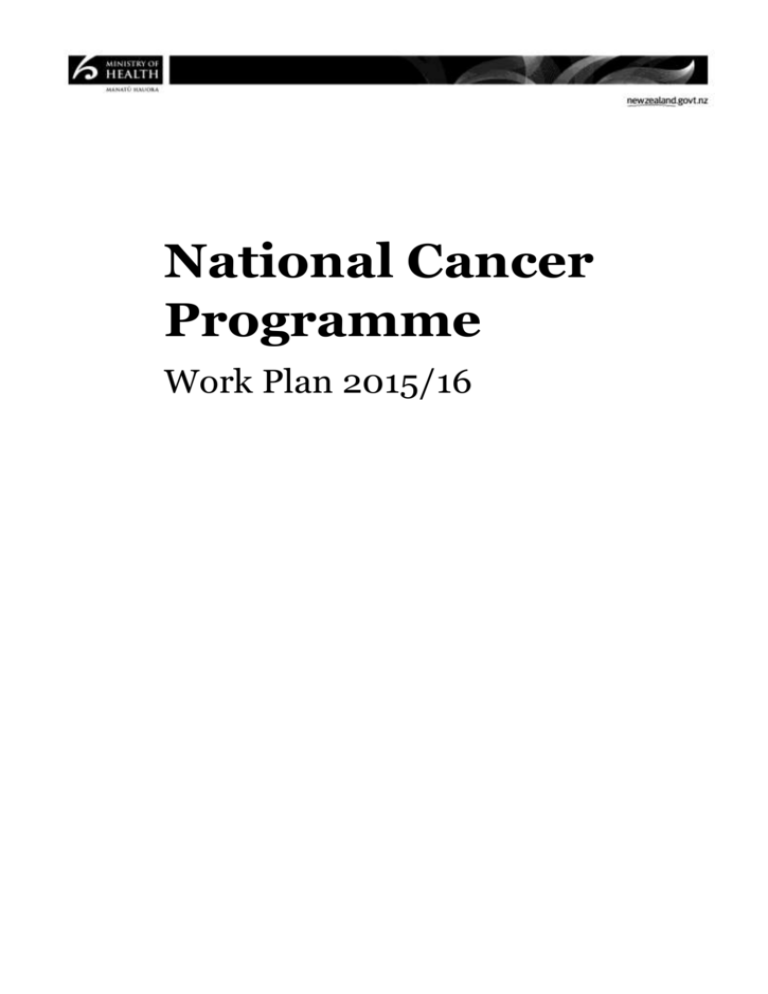
National Cancer Programme Work Plan 2015/16 Citation: Ministry of Health. 2015. National Cancer Programme: Work plan 2015/16. Wellington: Ministry of Health. Published in October 2015 by the Ministry of Health PO Box 5013, Wellington 6145, New Zealand ISBN: 978-0-478-44880-1 (online) HP 6260 This document is available at www.health.govt.nz Contents Overview 1 Introduction 1 Strategic context 1 Principles of programme delivery 2 New areas of focus 2 National Cancer Programme for 2015/16 Key work plan initiatives 5 5 References 10 National Cancer Programme: Work Plan 2015/16 iii Overview Introduction The National Cancer Programme brings together the work of the district health boards (DHBs), regional cancer networks and the Ministry of Health (the Ministry) to implement the Government’s priorities for cancer. This high-level work plan for 2015/16 covers national, regional and local priority activities. The DHBs’ annual plans, the regional cancer networks’ annual work plans and the Ministry’s business plans all provide more specific detail on the work that each of these groups is leading. The National Cancer Programme is an integrated programme of work with a strong consumer focus.1 There are established links with initiatives being led by the National Health Board, Health Workforce New Zealand and the National Health IT Board to: improve the coordination of health sector planning and service delivery achieve the National Cancer Programme priorities. Strategic context The New Zealand Cancer Plan 2015–2018 The New Zealand Cancer Plan: Better, faster cancer care 2015–2018 (Ministry of Health 2014a) provides an overview of all the activities that are currently underway in the broader cancer sector to improve cancer-related outcomes for all New Zealanders; and identifies what more needs to be done over the next three years. Its vision is for all people to have timely access to excellent cancer services that will enable them to live better and longer. This National Cancer Programme work plan outlines selected activities that will be undertaken in 2015/16 that will contribute to implementing the New Zealand Cancer Plan. 1 The work plan does not include activities associated with horizon scanning or new or emerging technologies, which is led by the National Health Committee. National Cancer Programme: Work Plan 2015/16 1 The Faster Cancer Treatment programme The Faster Cancer Treatment (FCT) programme is a key focus of the National Cancer Programme and is designed to reduce waiting times for appointments, tests and treatment; and standardise care pathways for all patients. Implementation activities include: service reviews against the provisional national tumour standards of service provision for eleven main tumour types disseminating service improvement funding of $11.2 million over five years to support DHBs to improve cancer treatment pathways improving the coverage and functionality of multidisciplinary meetings so that more patients benefit from a range of expert opinion implementing the Psychological and Social Support Workforce and Cancer Nurse Coordinator initiatives so that patients are better supported in their treatment pathway supporting quality clinical decision-making, including the development and implementation of a Cancer Health Information Strategy. The Faster cancer treatment health target measures how well the system performs for patients with cancer. The target is for 85 percent of patients to receive their first cancer treatment (or other management) within 62 days of being referred with a high suspicion of cancer and a need to be seen within two weeks by July 2016, increasing to 90 percent by June 2017. The 62-day timeframe is based on an international benchmark that allows time for clinicians to complete important tests and investigations that establish the diagnosis and ensure patients receive the best possible treatment and care. The Faster cancer treatment health target aims to support improvements in access and patient experience through the whole cancer pathway, including the period of investigations before treatment begins. It supports DHBs to identify any bottlenecks in the system and make improvements that benefit all cancer patients. Principles of programme delivery The following principles of programme delivery should be applied for all activities across the patient pathway: Wait times: all people get timely services Access: all people have access to services that maintain good health and independence Quality: all people receive services wherever they are Financial sustainability: all services make the best use of available resources. New areas of focus In recent years, the National Cancer Programme has focused on cancer service improvement, mainly through the implementation of the FCT programme and new models of care. The National Cancer Programme will continue to implement these essential activities, with an increasing focus on equity, health literacy and early detection. 1. Equity The National Cancer Programme aims to improve health outcomes for all New Zealanders affected by cancer. This means that people, irrespective of their ethnicity, gender, locality or socioeconomic status, must be able to have every opportunity to access services that will reduce 2 National Cancer Programme: Work Plan 2015/16 their risk of developing cancer, enable their cancer to be detected earlier as well as getting highquality cancer treatment quickly. The impact of cancer is much higher for Māori than the general population. The most up-to-date survival statistics show that non-Māori continue to have better one- and five-year survival than Māori (78.9 percent and 68.6 percent respectively for one-year survival and 64.7 percent and 49.3 percent for five-year survival). To improve cancer outcomes for Māori, the National Cancer Programme is guided by the overarching framework and aspirations in the refreshed He Korowai Oranga – Māori Health Strategy, (see Ministry of Health 2014a). A framework has been developed alongside He Korowai Oranga to drive improved equity in health care. DHBs have committed to applying the framework in their 2015/16 annual plans to improve the timeliness and quality of the cancer patient pathway. The National Cancer Programme will also apply this framework to work plan activities for 2015/16 to design new approaches that improve cancer outcomes for Māori. Current activities already underway include: supporting a Māori leadership group, Hei Āhuru Mōwai, to provide Māori leadership, participation and engagement across the cancer pathway the cancer nurse coordinator and psychological and social support workforce initiatives ongoing work of the Adolescent and Young Adult (AYA) Cancer Network Aotearoa analysis of the Faster cancer treatment health target data by ethnicity developing guidance for the early detection of lung cancer, with a focus on Māori. The regional cancer networks also have a focus on strengthening service delivery to Māori by: supporting Māori cancer leadership using a partnership approach implementing initiatives such as the Kia Ora – E te iwi programme in partnership with the Cancer Society improving data capture that includes ethnicity data for monitoring and evaluation. 2. Health literacy Good health literacy2 is essential to improving a person’s experience of the health system and enabling them to access services in an informed and timely way. Health literacy is supported by a health system focus on: services being easy to access and navigate effective health worker communication clear and relevant health messages that empower everyone to make informed choices. The Ministry has recently developed two health literacy resources to support a sustained effort and commitment to health literacy improvement. 1. Health Literacy Review: A guide helps organisations and services carry out a health literacy review to identify the things that support and challenge consumers, families and whānau when accessing services and managing their health. 2 ‘the capacity to obtain, process and understand basic health information and services in order to make informed and appropriate health decisions’ (Ministry of Health 2010) National Cancer Programme: Work Plan 2015/16 3 2. The Framework for Health Literacy provides guidance for the health and disability system to embed health literacy improvement into the core business of health. The framework applies the core principles of leadership, knowledge, safety, quality improvement and commitment to change across all levels of the health sector. The National Cancer Programme will develop a leadership approach in 2015/16, raising awareness and setting the expectation that good health literacy policy and practice contribute to individuals living longer, healthier, more independent lives. 3. Detecting cancer early Evidence suggests that up to one-third of all cancer cases could be cured if detected early and adequately treated (OECD 2013). Focusing efforts on detecting cancer early improves overall cancer survival rates (both one- and five-year rates). Recent international studies also show that for many cancers, the most socioeconomically deprived groups were more likely to have their cancer diagnosed at advanced stages than those least deprived. Internationally, countries have begun to successfully implement early prevention programmes as part of a whole cancer pathway approach. In countries such as Scotland and England, the programmes have largely been driven by the differences in survival rates seen in these two countries when compared with other neighbouring European countries. Similarly, while New Zealand has seen steady improvements in survival over the last 10 years, it remains behind Australia in terms of overall survival despite the quality improvements that have been implemented in recent times. Focusing on the front end of the pathway will likely reduce this gap, as well as improve one-year survival rates for Māori. In 2015/16, early detection activities will initially focus on lung cancer, as well as developing a broader medium-term plan for the early detection of cancer that will: identify cancers that will have the greatest impact on reducing disparities in cancer outcomes, with a specific focus on Māori identify cancers that will have the greatest impact on one- and five-year survival rates increase public awareness of symptoms and signs of cancer improve health literacy improve integration with primary health care and specialist services increase diagnostic capacity. 4 National Cancer Programme: Work Plan 2015/16 National Cancer Programme for 2015/16 Key work plan initiatives Over 2015/16, the Ministry, regional cancer networks and DHBs will deliver the following initiatives across the cancer pathway. Please note: DHBs’ annual plans, the regional cancer networks’ annual work plans and the Ministry’s business plans all include more specific detail on activities. National activities What Who The Ministry will design and purchase new tobacco control services, including: Prevention and early detection Diagnosis and treatment The Ministry will 3 Performance indicator New services commence 1 July 2016 health promotion, leadership and advocacy stop smoking treatment services support improvements in bowel cancer services Monitor implementation of the Bowel Screening Pilot on a quarterly basis Develop a business case by 30 June 2016 for the roll-out of a national bowel screening programme support coverage and service delivery improvements of breast and cervical screening programmes Increase breast screening coverage for women aged 50–69 years to 70% for all ethnic groups Increase cervical screening coverage3 to 80% for all ethnic groups support improvements in the early detection of lung cancer The National Lung Cancer Work Group work plan for 2015/16 implemented by December 2016 facilitate implementation of the prostate cancer quality improvement programme Implement guidance on prostate cancer active surveillance; and implement the Prostate Cancer Management and Referral Guidance support DHBs to achieve the Faster cancer treatment health target 85% of patients receive their first cancer treatment (or other management) within 62 days of being referred with a high suspicion of cancer and a need to be seen within two weeks by July 2016 Women aged 20 to 69 years screened in the previous three years. National Cancer Programme: Work Plan 2015/16 5 National activities What Who Performance indicator continue to implement the Faster cancer treatment programme, including: implementing the national tumour standards work programme supporting DHBs to implement the Cancer Nurse Coordinator Initiative supporting DHBs to implement service improvement fund round two initiatives improving coverage and functionality of MDMs develop radiation oncology metrics, a production planning tool and produce the next iteration of Radiation Oncology National Linear Accelerator and Workforce Plan (Health Partners Consulting Group 2014) Updated radiation oncology plan, ready for publication by 30 June 2016 The regional cancer networks will support Auckland and Waikato DHBs to finalise proposed service configuration for gynae-oncology services in New Zealand Service configuration confirmed by 1 July 2016 The Ministry will continue to support DHBs to improve medical oncology services Ongoing monitoring of implementation of the Knowledge and Skills Framework for Cancer Nurses support the AYA Network Aotearoa to deliver agreed work plan priorities Enablers The Ministry will 4 5 6 Implementation of high suspicion of cancer definitions for 10 tumour types by December 2015 Scoping of ongoing national tumour standards work programme completed by December 2015 Quarterly monitoring of the national nurse lead role and six-monthly monitoring of DHBs Service Improvement Fund project milestones met Quarterly DHB monitoring through policy priority 244 Develop standards that describe the level and quality of service for 12-24 year olds with cancer by June 2016. continue to support the National Child Cancer Network to deliver agreed work plan priorities Work plan priorities delivered by June 2016 continue to support DHBs to improve timely access to colonoscopy Achievement of the colonoscopy wait time indicator policy priority 295 implement the Cancer Health Information Strategy Establish governance board by December 2015 Implementation priorities identified and activities commenced by June 2016 support DHBs to implement the psychological and social support workforce initiative DHBs to appoint to roles by January 2016 National Lead annual work plan implemented by June 2016 review the extent of pressures on the medical physicist workforce to identify areas of need Scoping to develop a new approach to funding for the training and retention of Medical Physicists in New Zealand to be completed June 2016 scope the activities required to ensure a sustainable gynae-oncology surgical workforce In conjunction with the gynaecological oncology specialists, identify strategies for addressing the shortage of gynaecological oncologists by June 2016 DHBs are expected to improve the coverage and functionality of multidisciplinary meetings DHBs are required to collect, measure and monitor how long people are waiting for identified diagnostic procedures, including colonoscopy. Indicators are: a. 75% of people accepted for an urgent diagnostic colonoscopy will receive their procedure within two weeks (14 days) and b. 60% of people accepted for a diagnostic colonoscopy will receive their procedure within six weeks (42 days) c. 60% of people waiting for a surveillance colonoscopy will wait no longer than twelve weeks (84 days) beyond the planned date. National Cancer Programme: Work Plan 2015/16 Regional activities What Who The regional cancer networks will Diagnosis and treatment Enablers support DHBs to implement regional priority initiatives for: The regional cancer networks will Regular monitoring activities and reporting requirements met medical oncology services regional radiation oncology services support DHBs to implement the Faster cancer treatment programme, including Performance indicator support implementation of national tumour standards support DHBs to improve coverage and functionality of MDMs implementation of service improvement activities to improve cancer services Findings from the 2014/15 service reviews are implemented and the review of services against the next round of tumour standards are completed by June 2016 Quarterly monitoring DHB activity through policy priority 24 Service Improvement Fund project milestones met support DHBs to improve consistency of referral, and timeliness of access, to colonoscopy Achievement of the colonoscopy wait time indicator policy priority 29 support DHBs to implement the cancer psychological and social support workforce initiative Implementation of regional plans commence by January 2016 support DHBs to implement the Cancer Health Information Strategy Identify regional priorities and commence implementation by June 2016 National Cancer Programme: Work Plan 2015/16 7 Local activities What Who Prevention and early detection DHBs will 90 percent of pregnant women who identify as smokers upon registration with a DHB-employed midwife or Lead Maternity Carer are offered brief advice and support to quit smoking Diagnosis and treatment Follow-up care 95 percent of hospital patients who smoke and are seen by a health practitioner in a public hospital are offered brief advice and support to quit smoking 90 percent of PHO enrolled patients who smoke have been offered help to quit smoking by a health care practitioner in the last 15 months DHBs will 8 implement smoking cessation initiatives in hospitals and primary care Performance indicator implement ongoing activities associated with round two and three of the bowel screening pilot (Waitemata and Auckland DHBs). Quarterly reporting requirements on the implementation of the bowel screening pilot are met implement guidance on the use of active surveillance treatment for prostate cancer care Regular monitoring activities and reporting requirements met implement medical oncology service improvements All patients, ready for treatment, wait less than four weeks for chemotherapy implement Radiation Oncology Plan priorities All patients, ready for treatment, wait less than four weeks for radiotherapy implement the Faster cancer treatment programme by: Findings from the 2014/15 service reviews are implemented and the review of services against the next round of tumour standards are completed by June 2016 Quarterly reporting through policy priority 24 Regular monitoring activities and reporting requirements met Service Improvement Fund project milestones met DHBs will implementing national tumour standards and high suspicion of cancer definitions improving coverage and functionality of MDMs implementing the Cancer Nurse Coordinator Initiative implementing Service Improvement Fund activities and identify findings to improve patient pathways achieve the Faster cancer treatment health target 85% of patients receive their first cancer treatment (or other management) within 62 days of being referred with a high suspicion of cancer and a need to be seen within two weeks by July 2016 implement the endoscopy quality improvement tool Regular monitoring activities and reporting requirements met improve consistency of referral, and timeliness of access, to colonoscopy Achievement of the colonoscopy wait time indicator policy priority 29 continue to implement the Late Effects Assessment Programme (LEAP) All children completing cancer treatment are entered into LEAP National Cancer Programme: Work Plan 2015/16 continue to ensure information technology systems are in place that support consistency and quality of cancer data Monthly reporting against the 62-day Faster cancer treatment health target the 31-day Faster cancer treatment policy priority 30 (Part A)6 the Shorter waits for cancer treatment – radiotherapy and chemotherapy policy priority 30 (Part B)7 support the implementation of the Cancer Health Information Strategy Implementation priorities identified and activities commenced by June 2016 implement the cancer psychological and social support workforce initiative Recruitment to the psychological and social support roles by January 2016 Enablers DHBs will 6 7 Faster cancer treatment – 31-day indicator, which measures the length of time taken for patients to receive their first cancer treatment (or other management) from date of decision-to-treat Shorter waits for cancer treatment – radiotherapy and chemotherapy, which are the previous cancer target and measures that all patients ready for treatment wait less than four weeks for radiotherapy or chemotherapy from decision to treat. National Cancer Programme: Work Plan 2015/16 9 References Health Partners Consulting Group. 2014. Radiation Oncology National Linear Accelerator and Workforce Plan. Wellington: Ministry of Health. Ministry of Health. 2010. Ministry of Health. 2010. Kōrero Mārama: Health Literacy and Māori Results from the 2006 Adult Literacy and Life Skills Survey. Wellington: Ministry of Health Ministry of Health. 2014a. New Zealand Cancer Plan: Better, faster cancer care. Wellington: Ministry of Health. Ministry of Health. 2014b. The Guide to He Korowai Oranga – Māori Health Strategy. Wellington: Ministry of Health. OECD. 2013. Cancer Care: Assuring Quality to Improve Survival. OECD. 10 National Cancer Programme: Work Plan 2015/16
